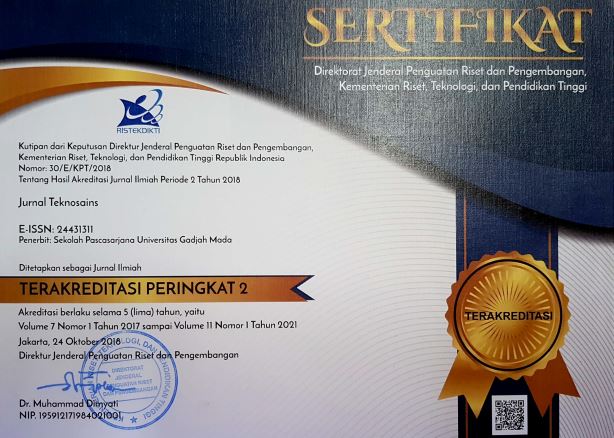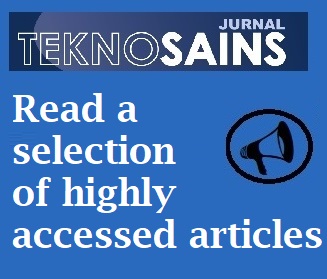Employing lipase of candida antarctica (calb) as catalyst in the acetylation of para-aminophenol in aqueous and water-free medium
Hilda Ismail(1*), Evi Lande Setiyani(2), Dwi Titus Indriyawati(3), B. S. Ari Sudarmanto(4)
(1) Laboratory of Organic Chemistry and Drug Synthesis, Faculty of Pharmacy, Gadjah Mada University
(2) Faculty of Pharmacy, Gadjah Mada University
(3) Faculty of Pharmacy, Gadjah Mada University
(4) Laboratory of Organic Chemistry and Drug Synthesis, Faculty of Pharmacy, Gadjah Mada University
(*) Corresponding Author
Abstract
Keywords
Full Text:
PDFReferences
Adams, JP, Brown, MJB, Rodriguez, AD, Lloyd, RC, and Roiban, GD (2019). Biocatalysis: A Pharm Perspective. Adv.Synth. Catal.,361: 2421–2432. DOI: 10.1002/adsc.201900424
Anderson, EM, Larson, KM, and Kirk, O (1998). One biocatalyst-many applications: the use of Candida antarctica B-lipase in organic synthesis. Biocatalysis Biotransformation,16(3) : 181-204. DOI : 10.3109/10242429809003198
Bjorkling, F, Frykman, H, Godtfredsen, SE, Kirk, O (1992). Lipase catalyzed synthesis of peroxycarboxylic acids and lipase mediated oxidations. Tetrahedron, 48(22) : 4587-4592
Djossou, AJ, Mazou, M, Toukourou, FP, Blin, J, Yao, KB, and Soumanou, MM (2016). Catalysis by Candida antarctica B (CaLB) immobilized in natural pure silica by adsorption: comparison with the free enzyme. Journal of Applied Biosciences,107 : 10418 - 10424. DOI: 10.4314/jab.v107i1.8
Dakin, HD (1905). The Fractional Hydrolysis of Optically Inactive Esters by Lipase Part II. J Phisiol, 32: 199-206. DOI : 10.1113/jphysiol.1905.s0001077
Ema, T (2004). Mechanism of enantioselectivity of lipases and other synthetically useful hydrolases. Current Organic Chemistry,8 : 1009–1025.
Hoff, BH, Anthonsen, HW and Anthonsen, T (1996). The enantiomer ratio strongly depends on the alkyl part of the acyl donor in transesterification with lipase B from Candida antarctica. Tetrahedron: Asymmetry,7 : 3187- 3192. DOI : 10.1016/0957-4166(96)00421-1
Indriyawati, DT (2019). "Asetilasi P-Aminofenol Melalui Reaksi Amidasi Oksidatif Terkatalisis Candida antarctica Lipase B (CaLB)". Skripsi, Indonesia: Fakultas Farmasi UGM, Yogyakarta.
Ismail, H, Lau, RM, Langen, LV, Van Rantwijk, F, and Sheldon, R (2008). “Easy on-easy off technology”: a fully enzymatic method for kinetic resolution of chiral amines. Journal of Advanced Catalysis, 350(10): 1511-1516. DOI: 10.1002/adsc.200800091
Ismail, H (2007). "Resolution of Chiral Amines". Disertation, The Netherlands: Delft University of Technology, The Netherlands,
Katzung, BG, Masters, SB, Trevor, AJ, (2012), Basic and Clinical Pharmacology, 12th Edition, New York: McGraw Hill Professional, p 1119
Kazlauskas, RJ and Weissfloch, ANE (1997). A enantiopreference of subtilisin toeard secondary alcohols and isosteric primary amines. Journal of Molecular Catalysis B Enzymatic,3 : 65-72. DOI : 10.1016/S1381-1177(96)00040-9
Lande, ES (2018). "Optimasi Suhu dan pH Dalam Sintesis Parasetamol Melalui Reaksi Transfer Asil pada p-aminofenol Rerkatalisis Candida antartica Lipase B". Skripsi, Indonesia: Fakultas Farmasi UGM, Yogyakarta.
Lau, RM (2003), "Lipases in Non-natural Reactions: Conversion in ionic Liquid and Resolution of Amines". Disertation, The Netherlands: Delft University of Technology, The Netherlands.
Magadum, DB and Yadaf, GD (2018). Chemoselective Acetylation of 2-Aminophenol Using Immobilized Lipase: Process Optimization, Mechanism, and Kinetics. ACS Omega,3 : 18528 - 18534. DOI : 10.1021/acsomega.8b01428
Martinelle, M, and Hult, K (1995). Kinetics of acyl transfer reactions in organic media catalysed by Candida antarctica lipase B. Biochimica et Biophysica Acta,1251 : 191-197. DOI: 10.1016/0167-4838(95)00096-d
Pleiss, J, Fischer, M and Schmid, RD (1998). Anatomy of lipase binding sites: the scissile fatty acid binding site. Chemistry and Physics of Lipids, 93 : 67-80
Pyka, A., Budzisz, M., Ma, B., & Do, B. (2013). Validation Thin Layer Chromatography for the Determination of Acetaminophen in Tablets and Comparison with a Pharmacopeial Method. Hindawi Publishing Corporation: Chromatography Research International, 2013
Schmidt, RD and Verger, R (1998). Lipases: Interfacial Enzymes with Attractive Applications. Angewandte Chemie International Edition,37 : 1608-1633. DOI : 10.1002/(SICI)1521-3773(19980703)37:12<1608::AID-ANIE1608>3.0.CO;2-V
Svedendahl, M, Carlqvist, P, Branneby, C, Allner, O, Frise, A, Hult, K, Berglind, P, and Brinck, T (2008). Direct Epoxidation in Candida antarctica Lipase B Studied by Experiment and Theory. Chembiochem, 9: 2443-2451. DOI: 10.1002/cbic.200800318
Sheldon, RA (1993), Chirotechnology, Marcel Dekker Inc., New York.
Van Damme, EJ, Cerdobbel, A, and Soetaart, W, (2005). Enzyme Catalysist in Organic Chemistry. Chim. Oggi,23 : 47-51
Van Rantwijk, F and Sheldon, RA (2004). Enantioselective acylation of chiral amines catalysed by serine hydrolases. Tetrahedron,60: 501-519. DOI: 10.1002/chin.200420230
Sigmaaldrich.com (1997). "Enzymatic Assay of LIPASE (EC 3.1.1.3) (Triacetin as Substrate)", March, 8th 2021, https://www.sigmaaldrich.com/deepweb/ assetsigmaaldrich/marketing/global/documents/302/964/lipase_triacetin.pdf
Zhang, L, Li, F, Wang, C, Zheng, L, Wang, Z, Zhao, R, and Wang, L (2017), Lipase-Mediated Amidation of Anilines with 1,3-Diketones via C–C Bond Cleavage. Catalysts,7 (4)115 : 1-9. DOI: 10.3390/catal7040115
Article Metrics
Refbacks
- There are currently no refbacks.
Copyright (c) 2021 Hilda Ismail, Evi Lande Setiyani, Dwi Titus Indriyawati, B. S. Ari Sudarmanto

This work is licensed under a Creative Commons Attribution-ShareAlike 4.0 International License.
Copyright © 2024 Jurnal Teknosains Submit an Article Tracking Your Submission
Editorial Policies Publishing System Copyright Notice Site Map Journal History Visitor Statistics Abstracting & Indexing









